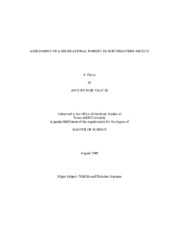| dc.description.abstract | The Northeastern region of Mexico has developed rapidly over the last few decades and reservoir construction has accompanied the growth of the region. As a result, recreational and sport fishing have become very popular. To regulate tournaments and to address growing exploitation concerns the Northeastern state of Nuevo Leon has begun to manage selected freshwater fisheries. Intensive management of warm water recreational species, however, does not have a long history in the region. This assessment was designed to evaluate the population structure and feeding habits of largemouth bass and channel catfish at a small rural fishery in Northeastern Mexico to get insight into mortality, growth, reproduction, and length related feeding patterns.
Largemouth bass and channel catfish at La Juventud experience high mortality rates more than likely due to the selective removal of larger-older fish by angling. Extended spawning efforts at lower latitudes have also been implicated in accelerating the mortality of reproductively mature largemouth bass; however, studies regarding the onset, frequency, and duration of largemouth bass spawning in Northeastern Mexico are necessary to determine spawning seasonality and the adverse effects that extended reproduction efforts may have on growth potential. Largemouth bass grow fast during the first year of life and attain large sizes by age 1. Growth of young-of-year may benefit from an early onset of spawning and a long first-growing season, an abundant multi-species forage base of small fish, and frequent utilization of fish. Growth to age 3 and quality size (300 - 380-mm TL) is similar to that of populations from the Southeastern U.S.; however, the growth potential of individuals older than age 3 appeared limited by suitable sizes of prey. Channel catfish mean length-at-age values were similar to the mean of means for length-at-age-3 values of fish in Texas, and larger than the mean values from several regions in the Southern U.S.A. Largemouth bass at La Juventud may spawn early in the year (early spring or earlier than spring) and late in the year (fall). Spawning success; however, may be adversely affected by fluctuating water levels associated with an arid climate and undesirable interactions with other nest spawning species. Day-time gill net collections in 2006 and 2007 may have under sampled channel catfish. Gill net catches were low and variable; thus, interpretation of length, age, and weight data were constrained by small sample size. | en |


